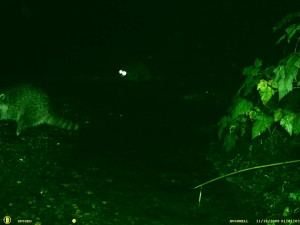Today we removed all of the signs and netting at the Trail.
While we were there we took a look at what was happening in the creek.
There were amazingly a few live chum, but most of them were in an advanced state of decay.
Notice the whiteness in the water around the fish? It isn’t a reflection, it is (they are) actually saprophytic oomycetes or (water molds). These molds are a keen source of food for the caddisfly larvae that put on their best growth at the time of the fall salmon return. You’ll notice that in the late summer and early fall, the caddisfly larvae, encased in a sheath of sand and rock particles, develop on the rocks in the stream bed, growing big enough to roam around (Larry Dominguez, personal communication 12/12/08).
This life history is one that has adapted to specific types of available nutrients at a certain time of year. It is one of the mecahnisms for the absorption into the food chain of marine derived nutirents (Larry Dominguez, personal communication, 12/12/08).
Here is a photo that shows the entire stream bed covered by the water molds:
Now, we like to keep it real here at SPSSEG….
and we just couldn’t help ourselves from prodding some carcasses to see what was happening inside of them…
and just beneath them…
Maggots galore! Yet another way the marine-derived nutrients pass from salmon to others in the food chain.
Here’s a little video for those of you who are interested in some more maggot action ; )
LETS NOT FORGET THE WILDLIFE CAMERA!
This is the first year we installed a game camera to catch predators in the act of eating the Kennedy Creek chum. Though we did not catch anything like bear (though we know they’re out there!), we did get some critters on film. (Alas, there is always next year.)
This week it is clear to me that salmon are such an integral part of the health of this ecosystem. Even in death they provide for new generations of many different organisms. In nature it seems nothing goes to waste!






